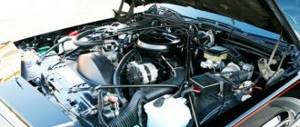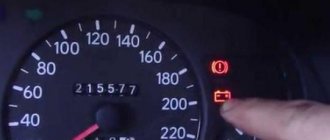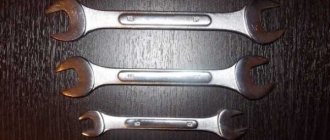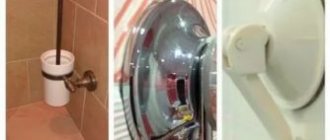What to do first
The expression “handbrake frozen” implies that due to severe frost, the brake pads have frozen to the discs. It is important not to confuse the concepts of when the pads jam and when they freeze. Jamming can occur at any time of the year (even in the heat). This means they are faulty.
The handbrake can freeze only at extremely low temperatures and when the wheels were wet (as a result of hitting a puddle or after washing) and you turned on the handbrake (handbrake) even for several hours.
First of all, to solve the problem, you can use the means at hand. Gasoline or any other liquid whose temperature is higher (warmer) than the air temperature can help here. You can also resort to the old-fashioned method - warm it up with fire.
To do this, you need to find paper in the cabin, set it on fire and bring it to the brake pads. It is very important to adhere to safety precautions and keep the fire at a safe distance from the car.
If you are faced with a problem when the handbrake of your car is frozen, the main thing is not to panic, so as not to do unnecessary and unnecessary actions. It is not recommended to forcibly tear off the pads using the power of the machine engine. This can have a detrimental effect on your vehicle.
So what to do in such cases, how to reanimate the pads?
The handbrake is frozen - what to do?
All drivers know that the handbrake should be used extremely carefully in winter. Application may cause the pads to freeze. Sometimes a car enthusiast puts the car in handbrake out of habit; there are no other options for parking. How to correct the situation, what to do if the car is “frozen”.
Needless to say, in winter it is better to leave the car in gear, if using a manual, in the “parking” mode on the automatic. If you need to leave the car on the parking brake, dry the pads before parking by pressing the pedal several times.
If the brakes are frozen, it’s worth figuring out how to deal with the problem.
The first thing to check is whether the problem really is frozen pads. Similar symptoms may occur if certain suspension components or transmissions malfunction. Be aware of these possibilities.
If the problem is still frozen pads, you can try to move the parts. To do this, raise/lower the handbrake lever five to six times. In some cases this is enough. Try to move. If it doesn’t help, move on to other methods.
You may come across a recommendation to pour boiling water on the brakes. Controversial, although sometimes it helps solve the problem. You will need a kettle of boiling water, just pour it on the wheels, trying to get it on the drums or calipers. Try lifting the brake lever several times and moving the car. The main disadvantage of this method is the risk of worsening the situation.
Try warming up the brakes with exhaust gases. You will need a hose of suitable diameter and length. The hose is put on the exhaust pipe and the engine is started, the exhaust is directed to the pads. The method takes time, but is effective.
It is possible to warm the wheels with a household hairdryer or a miniature gas burner. Such devices are not always at hand; if available, the problem can be solved quickly, with minimal effort.
As a last resort, try tapping the brakes. Take a block and use it to hit the brake disc or caliper with a hammer. Sometimes this method helps.
In car dealerships you can find special means for defrosting mechanisms. They are quite effective. The disadvantage is the need to dismantle the wheel for use. Sometimes there is a decrease in braking efficiency.
You should not try to warm up the wheel with a torch or blowtorch. This method may cause a fire. Be careful.
Options for defrosting the handbrake
So, if the handbrake is frozen, you need to take the following correct steps, which will completely solve the problem and continue to operate your car without any problems.
- The best solution to this problem is the use of special defrosters, which are used to defrost locks. If this is not at hand, then use a similar aerosol (only so that its freezing point is lower than the real one).
- Very often they use alcohol, gasoline or anti-freeze liquid for washing windows. After application, you must wait a while for the ice to thaw.
- If the handbrake is frozen, one of the options for solving this problem is hot water (but not boiling water). If it is possible to get hot water, take advantage of it. Even if you are not very close to your home. Try using this method, as it is less aggressive to the car’s elements. You need to pour water on the brake pads. After the brakes are released, you need to immediately start driving the car. At the same time, use the brake pedal to dry the spilled elements. When braking, the pads heat up, so all the existing moisture on them evaporates and it will not be able to freeze during the next stop.
- There is another option - a hair dryer. Of course, this option is not always feasible when the handbrake is frozen, since few people have this tool in their car. In addition, to connect it you need to have an outlet nearby.
- You can also use the original defrosting option, which was invented by experienced and resourceful drivers. But this method does not always work. To do this, you need to take a piece of hose and put it on the exhaust pipe. Each pad is heated as a result of the supply of warm gases from the exhaust pipe to it. To avoid freezing again, you need to start moving immediately.
- You can try (only very carefully) to rip off the pads, but only if it is not possible to use any other methods. To do this, you need to press the gas pedal little by little and make small jerks. The block will break only if it is slightly frozen. If you feel when the block is holding tightly, I recommend not using this option anymore.
What to do if the handbrake is frozen?
- If the car is “tightly” immobilized by frozen pads, try to move them with the parking brake handle. Press the handbrake two or three times until it stops, then release. If you manage to knock the ice out of the system, the lever will move without resistance. You can continue moving.
This method is quite effective, but there is a danger of damaging the lever or brake pads.
- Melt the ice with regular hot water, but not boiling water (it may crack the brake system elements). After 20–30 seconds, move away. Start moving immediately before the water freezes again.
Use a saturated saline solution as an alternative to water. This measure will release the handbrake and prevent the formation of a new ice crust.
Use special solutions. Products used to de-ice locking mechanisms and glass are ideal. Alternatively, use ethyl alcohol or regular vodka (they have non-freezing properties similar to technical liquids).
To remove severe icing using available chemicals, you may need to remove the rear wheels.
To remove severe icing, you can use hot water, saline solution or chemical compounds.
- Use the heat from the exhaust gases. Take a hose long enough to direct the hot stream from the exhaust pipe to the icy brake pads. The method is effective, but it will take a lot of time to get results.
- Remove ice from the discs using a rubber (wooden) hammer or other similar means at hand. Remove the rear wheels. Tap the brake mechanisms with a hammer.
Quite often the parking brake cable can become frozen. There are two effective options for solving the problem. You can try to heat the cable using improvised means or pour a defrosting agent into its jacket.
Attention! Do not use open fire, homemade torches or blowtorches to warm the brakes. This can lead to destruction of rubber products.
How to avoid freezing?
There are several practical tips, the implementation of which will allow you to avoid such a problem as a “frozen handbrake”. The brake will not freeze if you do:
- In order not to freeze, the first thing you need to do is relearn how to put the car on the handbrake in the winter. Depending on the type of transmission: a car with an automatic gearbox (automatic transmission) must be put in the parking position; if a car has a manual transmission, then use speed when parking. But, you can cheat a little: put the car on the handbrake, and after a few minutes remove it. Thus, in a few minutes ice could build up, which easily breaks off. After this, you can tighten the parking brake cable again (raise the handbrake).
- To prevent any pads from freezing, you need to dry them before parking. To do this, use the brake when driving. When it is pressed, as a result of friction, the pad and disc heat up and dry out.
- To prevent the brake elements from freezing, drive around puddles and snowy mess.
- You can adjust the gaps between these elements. This way you will prevent the parts from freezing and save yourself time.
Now you know exactly what to do when the handbrake of your vehicle freezes. Here's some good advice: it's better not to use the parking brake in winter. Make it a rule to set your car at speed. Well, if you still want to play it safe, then buy special aerosols.
Frozen pads: what to do
Most cars have rear drum brakes. This means that the pads are in a closed casing, which protects them from external influences - and at the same time can accumulate water.
Moisture gets into the brake mechanisms from the road and from splashes from the wheels of neighboring cars, and seeps out from under the wheel arch as the snow melts. Another common case is when the car is parked in the snow, it melts during the day and freezes in the evening. As a result, the trapped water freezes inside the brakes, holding the pads and metal drum together like superglue.
We do not recommend using extreme techniques to free the wheels, such as tapping the pads with a sledgehammer - everything can end not only without results, but in disastrous ways.
If the car is not stuck in a frozen puddle, in order for the pads and discs or drums to “release”, it is enough to start moving several times, rocking the car back and forth.
If this does not help, the easiest way to quickly defrost the pads is to fill a bottle with warm (not boiling water!) water and pour it over the pads over the protective casing. Water will wash away the ice film.
As soon as the wheels begin to turn, you need to completely dry the rear wheels. Move forward a little with the handbrake slightly tightened: the friction will warm up the pads and evaporate the remaining moisture.
- If you don’t have water on hand, you can use a cabin stove to heat some snow in a bottle.
- If you have disc brakes, anti-freeze glass cleaner will help defrost the pads.
Immediately after the car has started, press the pedal a couple of times at low speed, completely drying the discs. This will also help warm up the pads, making the brakes more effective.
To prevent the pads from freezing, it is also useful to dry them with 2-3 intense pedal strokes before parking the car.
What to do if the brake pads are frozen. And why is the handbrake better than the gear?
January 21, 2020 Category: Car secrets.
In winter, a situation can happen to every driver when, after clearing snow from the body and warming up the engine, the car refuses to drive. The engine roars, power is transmitted to the wheels, but the car stands rooted to the spot. This often happens after a long stay or in the morning. The reason is freezing pads.
Brake pads are frozen - what to do and how to defrost them?
The content of the article:
Good day, dear car enthusiasts! Do you know what we will never be able to insure either ourselves or, especially, our car against? That's right, from the whims of nature. To be more specific, from the surprises that it presents to us, especially in winter.
Situation. Winter. You drove and drove, stopped to do your business, or parked the car until the morning, or in a cold garage, in the morning, bam... the brake pads froze.
You need to drive, but you can’t tear it up; repairing the brake system is not a pleasant prospect. So, the question is, the brake pads are frozen, what to do in such a situation. Before you figure out how to warm up the brakes, you need to understand the reason why they freeze.
Why do brake pads freeze?
Replacing pads - how not to make a mistake
We kindly ask you not to confuse two completely different problems: if your brake pads are frozen or they are simply stuck. The cause of the second malfunction may be defects in the brake discs or brake pads, or a malfunction of the working cylinder rod.
If your brakes are frozen, then there are usually two reasons: either you drove into a puddle, although puddles are rare in winter, they do happen. Or, most often, you forgot or did not know that while driving, heated brakes contribute to the formation and collection of condensation.
When stopping in cold weather, if the pads are not adjusted correctly, too little clearance will form between them and the brake disc or brake drum. It is in this that the formed condensate freezes, “tightly” grabbing the brake disc and pad.
This situation can occur either with one wheel or with several at the same time. The main thing is that if the brakes are frozen, there is no need to test which is more powerful: the engine or the parts of the brake mechanism that are frozen to each other. You will definitely be convinced of the power of your car’s engine, but you can also be provided with brake repairs.
How to defrost brake pads if they are frozen?
Replacing brake pads - video
Here we will share people's experience on how to try to prevent your brake pads from freezing and how to defrost them.
The first rule is that when stopping or parking, so that they do not freeze, do not put the car on the parking brake (handbrake). Only for transmission.
The second rule is when planning a long stop (parking) in winter, try to “dry” the brakes. This means that before stopping, slow down several times so that the discs heat up and the moisture that has formed on them evaporates.
The third rule is, if possible, try to avoid puddles. If this fails, because it happens that the road is a continuous series of puddles, even in winter, then after overcoming the wet section, “dry” the brakes again.
But it happened anyway, and in the morning or leaving the office, you discovered that the brake pads were frozen.
Depending on the situation and available auxiliary means, we will consider options for how to warm up the brakes:
- try to move off smoothly. If the pads are not frozen too much, then you can tear them off the brake disc;
- hot water, not boiling water (in any convenient container) from home or from the parking lot security guard (office), you will always find it. When watering the brake disc, you will hear a characteristic crackling sound, this means the pad has thawed. Once you start driving, do not forget to “dry” the brakes again;
- if you have an outlet and an extension cord on hand, then you can use your wife’s hairdryer or an electric convector and use them to warm up the brake mechanism;
- if there is a hose, then put it on the exhaust pipe and direct it to the brake mechanism, warm air from the exhaust pipe will help the pad warm up.
In the winter season, try to systematically clean with a brush the holes designed to drain (drain) water from the brake mechanisms.
If your brake pads freeze too often, it is advisable to adjust the gap between them and the brake disc. How you do this, on your own or at a car service center, is up to you. But, brake adjustment is necessary.
Good luck on your journey.











